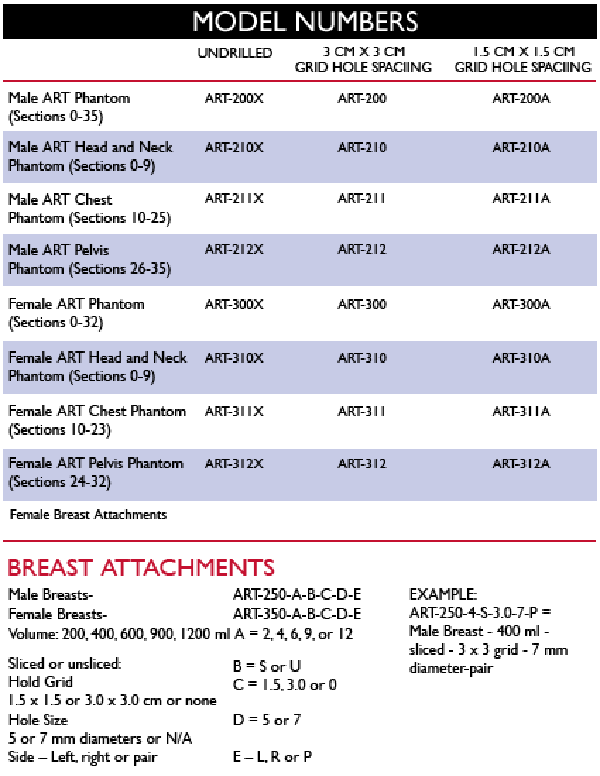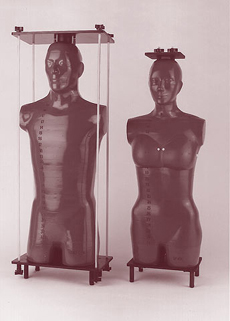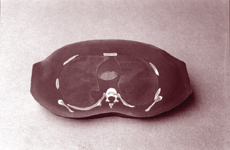Alderson Radiation Therapy Phantom (ART)
The Worldwide Standard for Quality Assurance for Radiation Therapy
The Alderson Radiation Therapy phantom (ART) and its earlier version, the Alderson RANDO phantom, have been in use for over 30 years. The ART has been refined and improved in both design and materials. These phantoms are indispensable quality-assurance tools; about 10,000 are in use all over the world. They provide integrated tests of the entire chain of treatment planning and delivery.
ART phantoms are molded of tissue-equivalent material; they are designed within highly sophisticated technological constraints and follow ICRU-44 standards. They are also designed for accuracy and ease of use. a large female.
ANATOMYThe male ART represents a 175 cm (5 ft. 9 in.) tall, 73.5 kg (162 lb.) male, and the female ART represents a 155 cm (5 ft. 1 in.) tall, 50 kg (110 lb.) female.
The ART phantom is transected-horizontally into 2.5 cm thick slices. Each slice has holes which are plugged with bone-equivalent, soft-tissue-equivalent or lung tissue equivalent pins which can be replaced by TLD holder pins. The holder pins are ordered separately.
Soft-tissue-equivalent coatings produce slices with glass smooth interfaces. These coatings are cut away over the air spaces of the oronasal pharynges, trachea and stem bronchi. Dosimetry holes are drilled in grids 3 cm x 3 cm or 1.5 cm x 1.5 cm in 5 and 7 mm diameters. These afford detailed measurements of dose distributions.
BREAST ATTACHMENTSThere is poor correlation between clothing brassiere sizes and breast volumes. Breasts are specified according to this table:
|
Volume 200 ml 400 ml 600 ml 900 ml 1200 ml |
Approximate Clothing Size A B C D DD |
Breasts are available in various sizes. They can be sliced in frontal planes (drilled or undrilled for film dosimetry). Slices can receive any of the pins listed below. Breasts of male and female ART phantoms are contoured to blend realistically with the thoraxes. They are attached to the thorax with nylon screws. The male chest with breasts attached serves as a large female.
MATERIALSSoft Tissues: There are unlimited, small variations in density and absorption throughout the human body. Phantom soft tissue is closely controlled to have the average density of these tissues.
Skeletons: RSD skeletons are highly-detailed polymer moldings which reproduce the shape, mass density and attenuation coefficients of cortical bone and spongiosa. They allow continuous production of phantoms, instead of the sporadic production required by the limited availability, variable size and uncertain chemical composition of human skeletons. These problems, plus loss of marrows in dried natural skeletons, make RSD skeletons superior to "real bone."
Molds for the RSD cortical bone and spongiosa were made from human skeletons consistent with the sizes of the softtissue molds.
RSD skeletons conform closely to the standards established by the International Commission on Radiation Units and Measurements (ICRU Report No. 44); mass density is reduced slightly to take into account a small decrease in calcium content for older patients.
Lungs: Lungs are molded from syntactic foam, with a specific gravity of 0.30 g/cc.
TLD DOSIMETERS AND FITTINGSPhantoms are shipped with all dosimetry holes filled with blank pins. Pins for TLD chips have recesses at one end 3.2 x 3.2 x 0.9 mm. Pins for TLD rods have 1 mm-diameter holes cross-drilled at the centers of the pins. All pins are 2.50 cm long unless otherwise specified.
TLD DOSIMETERS AND HOLDERS| Catelog N. | |
| TLD Chip Holders - 5mm or 7m | ART-10 |
|
TLD Rod Holders 1 mm diameter x 3 mm long - 5mm or 7mm |
ART-12 |
|
TLD Rod Holders 1 mm diameter x 6 mm long - 7 mm only |
ART - 15 |
| Blank Pins - 5 mm diameter | ART-20-S, L, B |
| Blank Pins - 7 mm diameter | ART-21-S, L, B |
|
S = Soft Tissue Equivalent L = Lung Tissue Equivalent B = Bone Tissue Equivalent |
|
| Note: ART-10 and ART-12 are interchangable in ART phantoms. | |
ASSEMBLY
ART phantom slices are held between aluminum plates by nylon tie rods. Knobs at the end of the rods clamp the slices tightly in proper alignment.
Both internal and external assembly devices are included. The external assembly facilitates film dosimetry, while the internal assembly is used generally with TLDs or ionchamber dosimetry.





